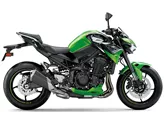Kawasaki Z900 2020 vs. BMW S 1000 R 2015

Kawasaki Z900 2020

BMW S 1000 R 2015
Overview - Kawasaki Z900 2020 vs BMW S 1000 R 2015
The Kawasaki Z900 2020 and the BMW S 1000 R 2015 are both naked bikes with inline four-cylinder engines. However, there are several notable differences between the two models.
In terms of engine power, the BMW S 1000 R 2015 has a clear advantage with 160 HP compared to the Kawasaki Z900 2020's 125.4 HP. This means that the BMW offers more acceleration and top speed potential. The torque figures also favor the BMW, with 112 Nm compared to the Kawasaki's 98.6 Nm.
Both bikes have a similar suspension setup, with upside-down telescopic forks at the front and a swing arm with a monoshock at the rear. However, the BMW S 1000 R 2015 has the added advantage of dynamic suspension, which enhances the bike's handling and comfort.

Kawasaki Z900 2020
In terms of chassis, the Kawasaki Z900 2020 features a steel frame, while the BMW S 1000 R 2015 has an aluminum frame. The aluminum frame offers a lighter weight and better handling characteristics. The BMW also has a twin tube frame, which further enhances stability and precision in cornering.
Both bikes have double disk brakes at the front with four pistons, but the BMW S 1000 R 2015 has the advantage of radial technology, which provides better braking performance.
In terms of advanced rider assistance systems, both bikes offer ABS, riding modes, ride by wire, and traction control. However, the BMW S 1000 R 2015 has the additional feature of dynamic suspension, which adjusts the suspension settings based on the riding conditions.

BMW S 1000 R 2015
In terms of dimensions and weights, the Kawasaki Z900 2020 has a slightly larger wheelbase at 1450 mm compared to the BMW S 1000 R 2015's 1439 mm. The seat height is also slightly lower on the Kawasaki at 795 mm compared to the BMW's 814 mm. The kerb weight with ABS is slightly higher on the Kawasaki at 210 kg compared to the BMW's 207 kg.
In terms of strengths, the Kawasaki Z900 2020 offers a powerful four-cylinder engine, great handling, good equipment, aggressive looks, and value for money. On the other hand, the BMW S 1000 R 2015 has a powerful and well-controllable engine, a powerful braking system, and a comparatively comfortable seating position.
In terms of weaknesses, the Kawasaki Z900 2020 has a somewhat tiring menu navigation and lacks the option for a quickshifter. The BMW S 1000 R 2015 has expensive optional extras, a hard chassis, and vibrations in the handlebars.
Technical Specifications Kawasaki Z900 2020 compared to BMW S 1000 R 2015
Pros and Cons in comparison
Pros and Cons in comparison
Kawasaki Z900 2020

In terms of price-performance, the Kawasaki Z900 is hard to beat at the moment. With the perfectly tuned engine, the high-quality chassis components and the electronics added for 2020, this naked bike offers everything that sporty riders will be looking for. There is really nothing to complain about, even if the option of a quickshifter would have been a nice extra. Apart from that: great shot, Kawasaki!
BMW S 1000 R 2015

With the BMW S 1000 R, you notice both the close relationship to the S 1000 RR superbike and the endeavour to equip the machine with a high degree of comfort for country roads and everyday use. Accordingly, the 1000cc four-cylinder power unit is brute and yet easily controllable, and the seating position is correspondingly sporty and comfortable. The fact that the S 1000 R is one of the most affordable power naked bikes is surprising and very pleasing, although one must not get hold of the list of optional extras - because thanks to the many irresistible features, it will certainly be more expensive.
Price Comparison Avarage Market Price Kawasaki Z900 vs BMW S 1000 R
There are a few key differences between a Kawasaki Z900 2020 and a BMW S 1000 R 2015. In terms of price, the actual average price of a BMW S 1000 R 2015 is about 18% higher. Compared to BMW S 1000 R 2015 there are more Kawasaki Z900 2020 bikes available on the 1000PS.de Marketplace, specifically 34 compared to 12. It takes less time to sell a BMW S 1000 R with 61 days compared to 124 days for the Kawasaki Z900. Since model year 2017 1000PS.de editors have written 46 reviews for the Kawasaki Z900 and 62 reviews for the BMW S 1000 R since model year 2014. The first review for the Kawasaki Z900 was published on 11/11/2016 and now has more than 93,200 views. This compares to more than 17,300 views for the first review on BMW S 1000 R published on 03/11/2013.





















